
- Saturday saw Ottawa’s armed riot police gain yet more ground in their bid to clear the city of Freedom Convoy protesters
- In just 30 minutes, officers armed with batons and rubber bullet guns managed to clear the area right up to Canadian Prime Minister Justin Trudeau’s official residence
- A total of 170 arrests were made on Saturday, and 50 vehicles were impounded
- The remaining protesters now appear to be making a ‘last stand’ in freezing weather, but they are outnumbered by Quebec cops, and the protest is expected to be smashed on Saturday
- Debate in Canada’s House of Commons was suspended on Friday in anticipation of the police action
- Trudeau needs the support of Parliament to continue using powers under the Emergencies Act
- Vote has been scheduled for Monday and will now be held sometime ‘early next week,’ leaders say
Heavily-armed police and riot cops were in control of downtown Ottawa streets late Saturday after a two-day military-style operation to smash the Freedom Convoy truck occupation.
At least 170 protestors have now been arrested since the start of the operation Friday morning and nearly 50 trucks and other vehicles have been towed off.
Scores of big rigs that had been lining the protest’s core area of Wellington Street beside the Parliament buildings are gone – some towed but most finally being driven away after truckers were given five-minute warnings before they would be arrested.
They vanished after police dramatically overran the central location, beside Prime Minister Justin Trudeau’s office, which has been the epicenter of the paralyzing three-week Freedom Convoy blockade by more than 300 trucks and which had a stage with a video screen and assorted food tents.
A smaller number of protest supporters were mingling around other streets into the night, some in small stand-offs against police lines but others just wandering around.
Ottawa’s interim police chief Steve Bell said of the operation: ‘It is going at this point exactly as we anticipated.’
On Saturday, the debate on whether Trudeau should have enacted the draconian Emergency Powers Act resumed, after being suspended Friday over claims the nearby protests had compromised Canadian MPs’ safety.
Some arrests were made as the line moved steadily from the Chateau Launier hotel – which had been the overnight holding position – and up Wellington Street to the Parliament buildings area.
Cops now easily outnumber the remaining protestors, who gathered after the first police thrust near their makeshift stage in what felt like a last stand in freezing temperatures and snowfall.
Within an hour they were also shunted from that area – which has been crucial to them – as a second wave of police action dispersed them to nearby streets.
Ottawa’s city cops were even more heavily armed than when the clearance operation began Friday. They were all carrying batons and were helmeted. Others had rubber bullet guns.
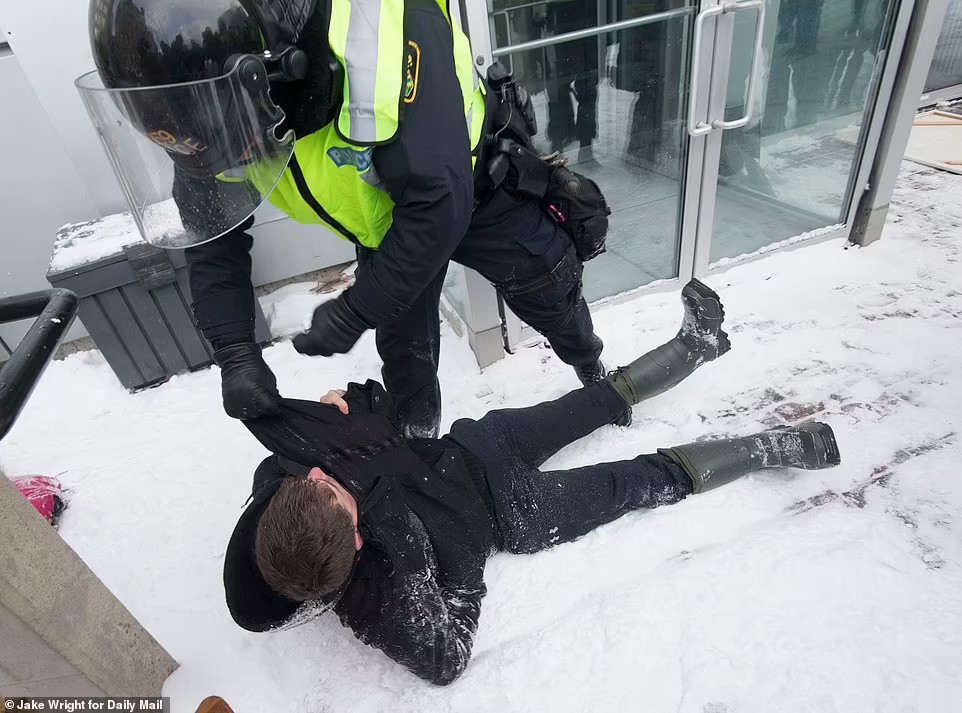
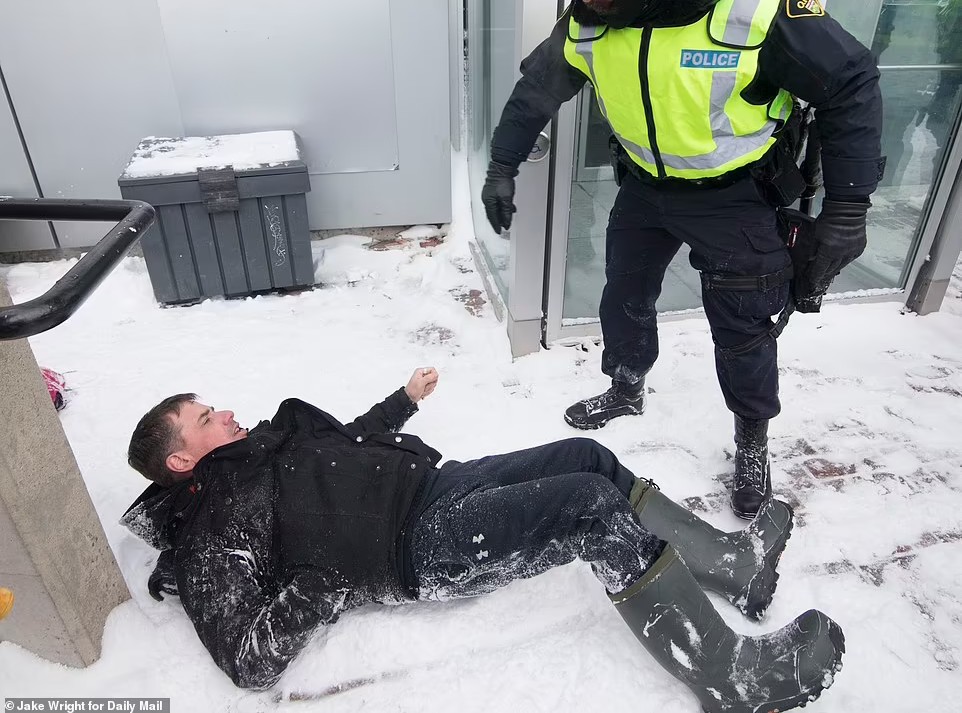
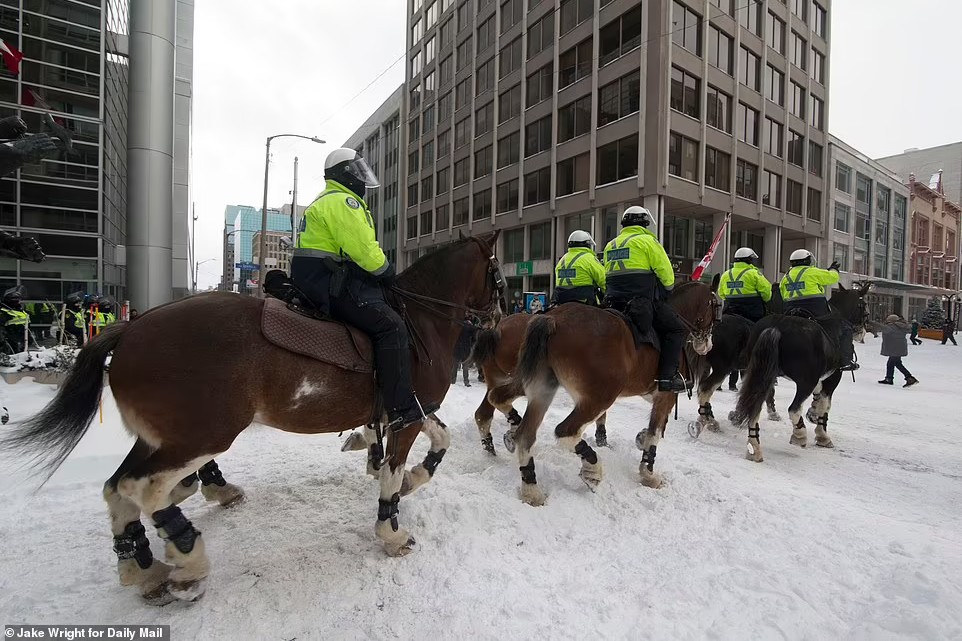


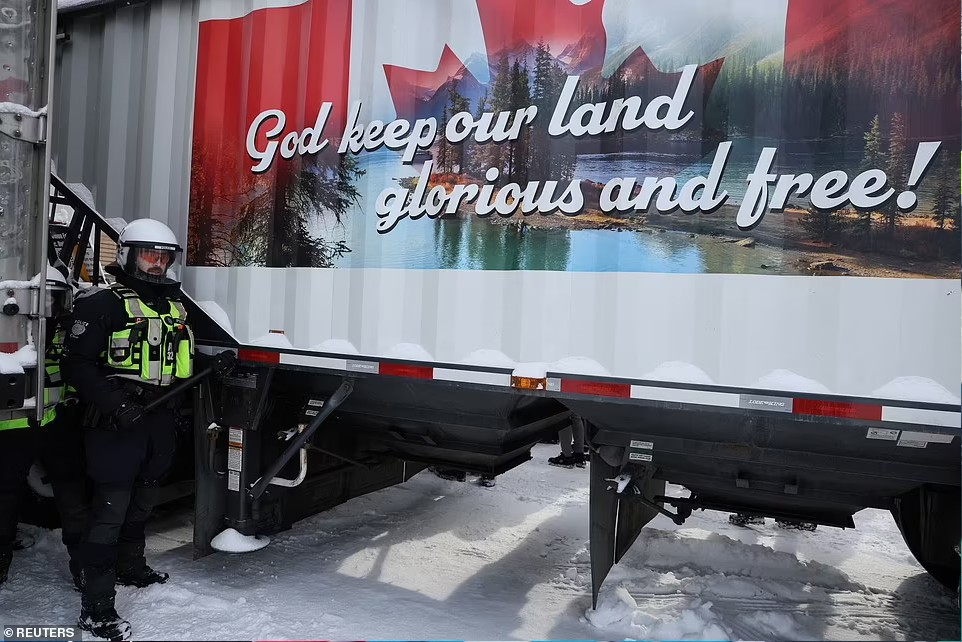

As the line halted almost under the window of Trudeau’s office, other ranks of the fearsome Surete du Quebec riot police – dressed in military-style green fatigues and with tear gas guns – assembled in the rear.
Also waiting in the background were several police horses, which were used Friday evening to storm through protestors after cops said officers were being attacked
Ottawa police had said they believe the bulk of the operation could be achieved Saturday.
By 11 a.m., the protesters’ stage and ‘community area’ which had food stands was overrun by police.
It was the central focus of the blockade outside Parliament buildings on Wellington Street – with a video screen and other facilities.
Farther down Wellington Street, police squads arrived and gave truckers and demonstrators there five minutes to get out – or be arrested. All three trucks there and one RV left. One of them was driven by a woman sobbing at the wheel.
As the trucks left, a small crowd cheered and applauded, calling them heroes.
The police operation on Saturday moved much faster than on Friday. Before lunchtime, they had taken control of the main area and were left with mopping up the side streets – which still contained a lot of vehicles at that point.
Ottawa interim police chief Bell updated the total number of arrests over two days to 170.
And he added of the operation: ‘It is going at this point exactly as we anticipated.’
Bell, who took over when former chief Peter Sloly resigned, said at a press conference: ‘This is tough work.
‘These officers are doing what they have been trained to do. They have demonstrated unparalleled discipline, restraint and the upmost professionalism.’
He said of the protestors: ‘At every step in the this operation we have been upfront and clear with the unlawful protestors that they must leave the area.
‘We have advised them of our enforcements efforts to they could continue to make informed decisions.
‘We backed up those warning with a deliberate and methodical operation using lawful and safe tactics.
Bell said his teams had faced ‘a barrage of resistance, shoving and vitriol’ at every stage.
‘We all saw the protestors were aggressive with the officers and we needed to use horses at one point,’ he added.
‘As a result we responded this morning by adding helmets and batons to our equipment for the safety of our officers.
At one point a flare was ignited by a protestor. Officers used a chemical irritant also known as pepper spray unlawful demonstrators who were resisting police orders.’
Bell condemned parents who are bringing children to the front line of the protest.
‘Sadly we again saw young children being brought to… the front of our police operation,’ he said.
‘This is dangerous and is putting young children at risk.’
It was the first signal from the nerve center of the protest that they are accepting they are in the final stages of the blockade.
Leaders also condemned police action against their protest.
A statement said: ‘The Freedom Convoy 2022 is shocked at the abuses of power by the low enforcement in Ottawa.
‘The police have horse-trampled on demonstrators and deployed riot control agents. They have beaten peaceful protestors with batons and with the stock of their guns.
‘We have therefore asked out truckers to move from Parliament Hill to avoid further brutality. To move trucks we will need time. This has been communicated to Ottawa police, and we hope that they will judicious restraint.
‘The truckers are moving, and the use of more force will only be used to punish people and it to preserve establish order.’
Around 9:15 a.m., cops issued a tweet aimed at demonstrators still near Chateau Laurier saying: ‘Protestors: we told you to leave. We have you time to leave.
‘We were slow and methodical, yet you were assaultive and aggressive with officers and the horses.
‘Based on your behavior, we are responding by including helmets and batons for our safety.’
Five minutes later they began their latest push.
One protestor launched a gas canister at the cops, according to another official tweet. It added: ‘Police response will be with public and officer safety in mind. Police remind protestors to remain peaceful.’
Dozens of truckers have now abandoned the protest and driven their rigs away from the area – despite earlier saying they were going nowhere.
Numbers of demonstrators, who made the same vow to media, have also dwindled drastically in the face of patient but determined police action.
Seven law enforcement agencies are involved in the swoop to regain the streets.
Among the police units on the ground are the fearsome Surete du Quebec riot cops, dressed in green military-style fatigues, helmets and visors and wielding batons. Some were also brandishing tear gas guns and already wearing gas masks.
The operation began with a tense face-off between a large contingent of Ottawa cops – dressed in blue tactical gear and some with rubber bullet guns – confronting demonstrators near the Westin hotel on the edge of the police’s new ‘secured zone.’ Police horses were in the background.
DailyMail.com witnessed four arrests of individuals who were singled out and wrestled to the ground before being cuffed with zip ties and led away.
Officers faced taunts and shouts as they slowly moved the crowd back towards the iconic Chateau Laurier hotel, about 400 yards from the protest epicenter beside the Parliament Buildings.
As he watched cops advance, protestor Dallon – who would not give his last name – told DailyMail.com: ‘This is a sledge hammer to kill a fly.
‘I’m not afraid to get arrested. In fact I’m expecting it. But they know why we are here and many of them are actually with us.’
The number of demonstrators thinned out with the first police surge in the highly fluid situation. Organizers could be heard trying to rally protestors to ‘hold the line’ farther back.
One, who had a British accent, appeared to be a demonstration co-ordinator. He rushed past us as he yelled to others: ‘Go back, hold the line in Wellington Street (closer to the main blockade). We’re just going to get arrested here,’
As the crowd was corralled up the street to a group of parked trucks, at least 50 of the Surete du Quebec riot cops appeared to come out of nowhere and the tension rose dramatically.
The daunting military-style figures blocked anyone leaving their self-imposed perimeter, warning everyone including the media that they faced arrest.
Minutes later, they formed a single line, separating demonstrators from the road intersection near the Chateau Laurier that had been taken over by truckers.
Three riot cop spotters were seen on the roof of the building being used as the temporary home of the Canadian Senate, which overlooks the stand-off area. A drone was flying overhead.
Demonstrators yelled ‘shame on you’ and chanted at the officers, who stood immobile for at least two hours in what appears to be a patient and methodical police operation.
One man stripped off his shirt and got down on his knees in an imploring gesture as he begged them to back off.
However, behind the wall of riot cops other officers could be seen arresting truckers who had stayed in their rigs which were overrun by the law enforcement surge near the Chateau Laurier.
Cops could be seen knocking on the door of trucks to get the drivers to come out. Most complied, although at least one tried to stay put and an officer breached the door to pull him out.
The arrested drivers all ended up sprawled on the snow, made to put their arms behind their backs and were then cuffed before being led away.
And the tension rose dramatically just before 5pm when a column of police horses moved in as the riot cops began another surge to claim more ground. By 6.25pm the riot police were holding a new line slightly closer to the Parliament Buildings.
Ottawa cops said their officers had been attacked. They tweeted: ‘Protestors are assaulting officers, have attempted to remove officers’ weapons. All means of de-escalation have been used to move forward in our goal of returning Ottawa to its normalcy.’
And the force also issued an official alert graphic on Twitter, reading: ‘Demonstrators you must leave. Anyone found within the zone will be arrested.’
It reinforced the message by adding: ‘You must leave. You must cease further unlawful activity and immediately remove your vehicle and/or property from all unlawful protest sites. Anyone within the unlawful protest site may be arrested.’
Some demonstrators remained defiant but appeared shaken by the initial police surge. However, as the day drew on their spirits lifted. More and more protestors began to congregate in the stand-off area.
It is clear that the combined police operation is working to a specific and patient plan, however the demonstrators also appear well organized – and now largely unfazed.
Dozens were roaming around filming on their phones and dictating a narrative as they live-streamed on social media.
As word spread of the dramatic police action, at least 14 trucks near the Parliament Buildings drove off from the spots where they had been for three weeks.
Back at the makeshift stage almost under the office window of Prime Minister Justin Trudeau, the atmosphere was surreal.
While riot cops were cracking down just 300 yards away, music was still blaring from the stage and a performer was trying to keep up the spirits of protestors huddled around and dancing.
Among truckers parked on Parliament Hill near Trudeau’s office, the mood was growing philosophical as the law enforcement surge tightened its grip.
Eric, who would not give his last name, was carrying fuel cans to his rig parked in Wellington St beside the Parliament Buildings.
He said of confronting police when it comes: ‘We are going to be peaceful. So if the police come in, knocking on our doors, arresting us or telling us we have to leave then that’s going to happen.
‘We will do our best to be peaceful and to comply as much as we can with police orders.’
He added: ‘We are not sure what is going to happen. They are arresting some drivers and towing some trucks. But I understand that here in Wellington Street we are allowed to be here, this is legal.
‘We are not breaking any laws, we have lawyers saying that.
‘We are being lawful so from that standpoint that is why we are still here and whatever comes from there.
‘I think we are on our way to this protest being a success. There is a lot of hard work needed after this. I think we opened up a lot of eyes. A lot of people who were afraid to speak up are now speaking up. The Prime Minister was not willing to speak with us at all, he just totally discredited us.’

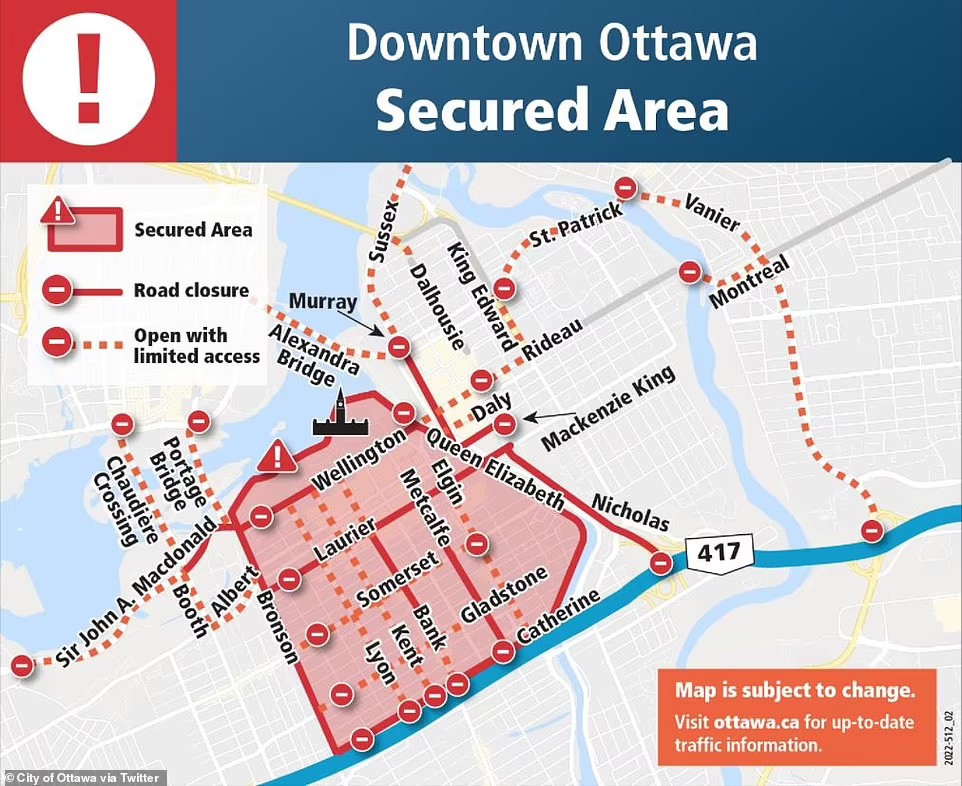
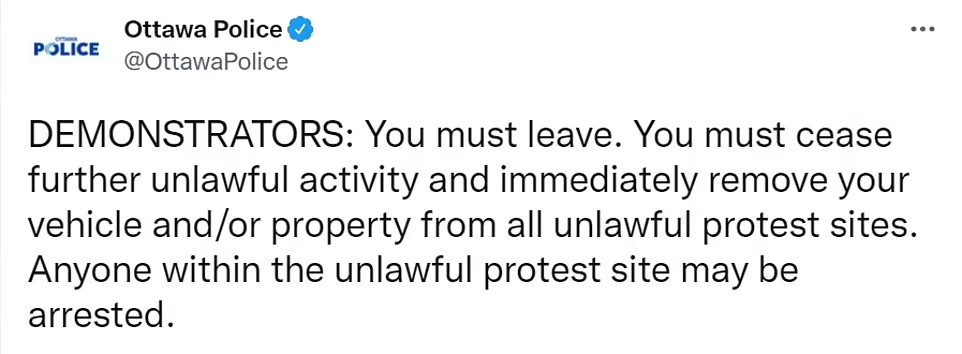
Using powers under the Emergencies Act, Ottawa cops have established a ‘no-go’ zone with 100 checkpoints encircling the Freedom Convoy, cutting them off from support and preventing additional protesters from joining the demonstration blockading the streets around Parliament Hill.
During Friday’s crackdown, Ottawa Police issued a statement on Twitter threatening to arrest journalists covering the sweep, alarming free press advocates.
‘All media who are attending the area, please keep a distance and stay out of police operations for your safety,’ the department said.
‘Anyone found within areas undergoing enforcement may be subject to arrest. There will be a media availability later today,’ the statement added.
Ottawa Police also said as the crackdown unfolded that there was a ‘concerted effort to flood our 911 and non-emergency policing reporting line.’
‘This endangers lives and is completely unacceptable,’ said OPS.
‘Some protesters are surrendering and are being arrested. We ask protesters to remain peaceful and lawful,’ Ottawa police said in an alert.
Some demonstrators were seen being led away in handcuffs. One person being led away was carrying a sign that read ‘Mandate Freedom.’
Meanwhile, the city’s Light Rail Transit line was suspended Friday in the section that runs underneath Ottawa’s truck blockaded downtown.
The service runs above ground either side of district, and is normally a busy commuter route bringing people in.
Officials have cited weather reasons for the closure, following a prolonged snowfall in the city and temperatures down to 5 degrees Fahrenheit.
However shutting the downtown service effectively reinforces Ottawa police’s new security zone around the area announced Thursday by Chief Bell.
The truckers, joined by thousands of demonstrators and some 400 vehicles, turned the streets around Parliament into a noisy party zone since first arriving on January 28, in what has become one of the worst crises to hit Trudeau since he took power in 2015.
Police made a handful of arrests Thursday evening, including of Barber, one of the main fundraisers and organizers, after authorities said action was imminent. Barber went without resistance after police told him he was being arrested for mischief.
‘We absolutely are committed to end this unlawful demonstration. We have the plan, we have the commitment, we have the resources,’ Chief Bell told reporters on Thursday.
Police will set up a perimeter with 100 checkpoints around downtown to stop people without legitimate reason from entering, he said.
‘This weekend will look very different than the past three weekends,’ he added.
Previous chief Peter Sloly quit this week amid residents’ fury about what they saw as police inaction.
The truckers’ protests started against vaccine mandates for cross-border drivers, a measure in place in the United States, too. But slowly it spread across Canada and morphed into an anti-government movement.
Protesters blocked several land crossings with the United States, including the busiest, the Ambassador Bridge which connects to Detroit, for six days, hurting both economies.
Calling the blockades a threat to democracy, Trudeau invoked emergency measures on Monday giving his government extraordinary powers to end the unrest. Government officials said they were worried about extremists causing violence.
Under law, any use of the Emergencies Act must be brought before Parliament within seven days for approval.
Debate began Thursday and will continue, according to the Act, ‘without interruption’ until the vote is called. After Friday’s planned vote was cancelled, the House faced a Monday deadline to act.
Addressing the House on Thursday, Trudeau pleaded with legislators to support his extraordinary powers, which have enabled him to summarily freeze bank accounts and crypto wallets tied to the protests in a bid to cut off funding for the movement.
‘It’s high time that these illegal and dangerous activities stop,’ Trudeau declared in Parliament, not far from where the more than 300 trucks were parked in the protest’s final stand around Parliament Hill.
‘They are a threat to our economy and our relationship with trading partners,’ he said. ‘They are a threat to public safety.’
Opposition Leader Candice Bergen of the Conservative Party responded by slamming Trudeau’s request as ‘not consistent with fundamental freedoms.’
‘The Government should not have the power to close the bank accounts of Canadians on a whim,’ Bergen told Parliament.
‘I urge all members of this House—proceed with extreme caution. Now is the time to stand up for your constituents, to show real leadership, to help heal our divisions, to listen to those we disagree with.’
Yves-François Blanchet, the leader of the center-left Bloc Québécois, said that his party would join with Conservatives in opposing Trudeau’s emergency powers.
In Quebec, the memory of the 1970 October Crisis, when Trudeau’s father flooded the streets with soldiers using emergency war powers in response to a diplomat’s kidnapping, still rings bitterly for many.
However, when NDP leader Jagmeet Singh signaled his party’s support for Trudeau, it became clear that the Liberals would almost certainly have the votes to defeat any opposition.
Singh said his party would withdraw its support if the emergency powers are abused, telling the House that Canada reached this point through a failure of political and police leadership at multiple levels.
‘We are not proud of supporting these measures,’ Singh said in response to a question.
Meanwhile, many protesters on Parliament Hill said they would not leave until their demands were met.
‘End the mandates, give us our rights and this is over,’ said Chris Dacey on Thursday. ‘We’ll all go back to our families.’
The border blockades turned the pressure on Trudeau to act swiftly, and U.S. President Joe Biden asked him to use federal powers.
‘The illegal blockades and occupations have to stop and the borders have to remain open,’ Trudeau told legislators on Thursday as Parliament started debate on the Emergencies Act, which needs to be passed within seven days of an announcement.
But the official opposition Conservative Party says there was no need for the Emergencies Act, especially since the border blockades are over.
Conservative Parliamentarian Jeremy Patzer told the House of Commons on Thursday that people around the world were alarmed to see Trudeau ‘come down on peaceful protesters with a sledgehammer.’
‘It is absolutely shameful,’ he added.

